Details
Théo van Rysselberghe (1862-1926)..
Portrait d'Émile Verhaeren
monogrammé et daté 'Sept. 18 TVR 92' (en haut à gauche); signé, signé des initiales, daté et inscrit 'Emile Verhaeren en septembre 1892 à Hemixem T.V.R.' (au revers du montage).
fusain sur papier
54.2 x 41.6 cm.
Exécuté à Hemixem le 18 septembre 1892
signed with the monogram and dated 'Sept. 18 TVR 92' (upper left); signed, signed with the initials, dated and inscribed 'Emile Verhaeren en septembre 1892 à Hemixem T.V.R.' (on the reverse of the mount)
charcoal on paper
21 3⁄8 x 16 ½ in.
Executed in Hemixem on 18 September 1892..
Provenance
Atelier de l’artiste.
Maria van Rysselberghe, Saint-Clair (par succession).
Élisabeth van Rysselberghe, Paris (par descendance).
Catherine van Rysselberghe Gide (par descendance); vente, Christie's, Paris, 1 décembre 2006, lot 1.
Sam Josefowitz, Pully (acquis au cours de cette vente).
Puis par descendance aux propriétaires actuels.
Literature
E. Verhaeren, Émile Verhaeren, 1883-1896, Pour les amis du poète, Bruxelles, 1896 (illustré en quatrième de couverture).
E. Verhaeren, 'Théo Van Rysselberghe', in Ver Sacrum, Zeitschrift der Vereinigung Bildender Küenstler Oesterreichs, novembre 1899, No. 11, p. 28 (illustré; daté '1893').
P. de Mont, 'Zuid- en Noordnederlandse Kunstenaars van nu, Théo Van Rysselberghe' in Kunst & Leven, Tijdschrify voor Kunst en Bellettrie, 1903, p. 15 (illustré).
M. Gauchez, Émile Verhaeren, Monographie-critique, Bruxelles, 1908, p. 81.
La Lanterne, Bruxelles, 4 juillet 1962.
La Meuse, Liège, 8 juillet 1962.
G. Veronesi, 'Neo-impressionnisti, Paul Signac e Théo Van Rysselberghe', in Emporium, mars 1964, p. 103 (illustré).
Belgian Art, 1880-1914, cat. exp., The Brooklyn Museum, New York, 1980, p. 45 (illustré).
R. Feltkamp, Théo Van Rysselberghe, Bruxelles, 2003, p. 295, no. 15 (illustré)..
Exhibited
Bruxelles, Galerie Giroux, Théo Van Rysselberghe, Exposition d'ensemble, novembre-décembre 1927, p. 34, no. 9 (illustré, fig. 9).
Bruxelles, Bibliothèque Royale de Belgique, Centenaire de Verhaeren, mai-juin 1955, p. 75, no. 217.
Gand, Musée des Beaux-Arts, Rétrospective Théo Van Rysselberghe, juillet-septembre 1962, p. 61, no. 194 (illustré, pl. LV).
Luxembourg, Musée d'Histoire et d'Art, Théo Van Rysselberghe, octobre-novembre 1962, p. 14, no. 72.
Le Lavandou, Espace Culturel, Théo Van Rysselberghe intime, juillet-septembre 2005, p. 103, no. 48 (illustré en couleurs, p. 77; illustré in situ, p. 6).
Bruxelles, Palais des Beaux-Arts et La Haye, Gemeentemuseum, Théo Van Rysselberghe, février-septembre 2006, p. 257 (illustré en couleurs, p. 80).
Bruxelles, ING Cultural Centre et Indianapolis, Indianapolis Museum of Art, The Neo-Impressionist Portrait, 1886-1904, février-septembre 2014, p. 192 (illustré en couleurs, pl. 54).
Washington, D. C., The Phillips Collection, Neo-Impressionism and the Dream of Realities, Painting, Poetry, Music, septembre 2014-janvier 2015, p. 15, no. 11 (illustré en couleurs).
Further Details
Entre 1885 et 1915, Théo Van Rysselberghe portraitura son compatriote et ami le poète symboliste Emile Verhaeren à plus d'une vingtaine de reprises, le plus souvent assis à sa table de travail, en train d'écrire.
C’est Van Rysselberghe qui, comme l’explique Verhaeren en avril 1891 dans La Société nouvelle, fit irruption chez lui le 31 mars vers midi pour lui montrer, tout abasourdi, la lettre de Signac annonçant la mort de Seurat ; mais c’est aussi Verhaeren qui, au printemps 1891, fait une relation enthousiaste dans La Nation de l’envoi de Rysselberghe aux Indépendants, puis admire en 1893 la finesse des portraits présentés aux XX : «L’extérieur, l’enveloppement, la vie d’épiderme leur est spécialement joie et excitation. Et cette vie, ils [Rysselberghe et Signac] la sentent plus subtilement et plus triomphalement qu’on ne la sentit jamais avant eux. Ils sont la résultante de tout le mouvement réaliste et impressionniste de cette dernière moitié de siècle.» (É. Verhaeren, La Nation, 12 mars 1893). Ces mots semblent écrits pour le portrait tant ils évoquent l’intensité de la vie intérieure que Rysselberghe traduit ici à travers un très complexe réseau de lignes entremêlées. La lumière qui vient frapper le visage et s’épanouir en une sorte d’orbe semble matérialiser l’inspiration même de l’écrivain. Ce n’est sans doute pas par hasard que ce dessin a été choisi pour illustrer un article consacré à l’artiste, paru en 1899 dans Ver Sacrum, la si moderne revue de la Sécession viennoise.
Between 1885 and 1915, Théo Van Rysselberghe painted more than twenty portraits of his compatriot and friend, the Symbolist poet Emile Verhaeren, usually sitting at his desk, writing.
It was Van Rysselberghe who, as Verhaeren explained in April 1891 in La Société nouvelle, burst into his house at around midday on 31 March to show him, dumbfounded, Signac's letter announcing Seurat's death; but it was also Verhaeren who, in the spring of 1891, wrote an enthusiastic review in La Nation of Rysselberghe's submission to the Indépendants, and then in 1893 admired the finesse of the portraits presented at the XX: "The exterior, the envelopment, the life of the epidermis is especially joyful and exciting for them. And they [Rysselberghe and Signac] feel this life more subtly and more triumphantly than ever before. They are the result of the whole realist and impressionist movement of the last half-century". (É. Verhaeren, La Nation, 12 March 1893). These words seem written for the portrait, so much do they evoke the intensity of the inner life that Rysselberghe translates here through a complex network of intertwined lines. The light that strikes the face and blossoms into a kind of orb seems to materialise the writer's own inspiration. It was no coincidence that this drawing was chosen to illustrate an article devoted to the artist, published in 1899 in Ver Sacrum, the very modern journal of the Viennese Secession.
Details
Théo van Rysselberghe (1862-1926)..
Portrait d'Émile Verhaeren
monogrammé et daté 'Sept. 18 TVR 92' (en haut à gauche); signé, signé des initiales, daté et inscrit 'Emile Verhaeren en septembre 1892 à Hemixem T.V.R.' (au revers du montage).
fusain sur papier
54.2 x 41.6 cm.
Exécuté à Hemixem le 18 septembre 1892
signed with the monogram and dated 'Sept. 18 TVR 92' (upper left); signed, signed with the initials, dated and inscribed 'Emile Verhaeren en septembre 1892 à Hemixem T.V.R.' (on the reverse of the mount)
charcoal on paper
21 3⁄8 x 16 ½ in.
Executed in Hemixem on 18 September 1892..
Provenance
Atelier de l’artiste.
Maria van Rysselberghe, Saint-Clair (par succession).
Élisabeth van Rysselberghe, Paris (par descendance).
Catherine van Rysselberghe Gide (par descendance); vente, Christie's, Paris, 1 décembre 2006, lot 1.
Sam Josefowitz, Pully (acquis au cours de cette vente).
Puis par descendance aux propriétaires actuels.
Literature
E. Verhaeren, Émile Verhaeren, 1883-1896, Pour les amis du poète, Bruxelles, 1896 (illustré en quatrième de couverture).
E. Verhaeren, 'Théo Van Rysselberghe', in Ver Sacrum, Zeitschrift der Vereinigung Bildender Küenstler Oesterreichs, novembre 1899, No. 11, p. 28 (illustré; daté '1893').
P. de Mont, 'Zuid- en Noordnederlandse Kunstenaars van nu, Théo Van Rysselberghe' in Kunst & Leven, Tijdschrify voor Kunst en Bellettrie, 1903, p. 15 (illustré).
M. Gauchez, Émile Verhaeren, Monographie-critique, Bruxelles, 1908, p. 81.
La Lanterne, Bruxelles, 4 juillet 1962.
La Meuse, Liège, 8 juillet 1962.
G. Veronesi, 'Neo-impressionnisti, Paul Signac e Théo Van Rysselberghe', in Emporium, mars 1964, p. 103 (illustré).
Belgian Art, 1880-1914, cat. exp., The Brooklyn Museum, New York, 1980, p. 45 (illustré).
R. Feltkamp, Théo Van Rysselberghe, Bruxelles, 2003, p. 295, no. 15 (illustré)..
Exhibited
Bruxelles, Galerie Giroux, Théo Van Rysselberghe, Exposition d'ensemble, novembre-décembre 1927, p. 34, no. 9 (illustré, fig. 9).
Bruxelles, Bibliothèque Royale de Belgique, Centenaire de Verhaeren, mai-juin 1955, p. 75, no. 217.
Gand, Musée des Beaux-Arts, Rétrospective Théo Van Rysselberghe, juillet-septembre 1962, p. 61, no. 194 (illustré, pl. LV).
Luxembourg, Musée d'Histoire et d'Art, Théo Van Rysselberghe, octobre-novembre 1962, p. 14, no. 72.
Le Lavandou, Espace Culturel, Théo Van Rysselberghe intime, juillet-septembre 2005, p. 103, no. 48 (illustré en couleurs, p. 77; illustré in situ, p. 6).
Bruxelles, Palais des Beaux-Arts et La Haye, Gemeentemuseum, Théo Van Rysselberghe, février-septembre 2006, p. 257 (illustré en couleurs, p. 80).
Bruxelles, ING Cultural Centre et Indianapolis, Indianapolis Museum of Art, The Neo-Impressionist Portrait, 1886-1904, février-septembre 2014, p. 192 (illustré en couleurs, pl. 54).
Washington, D. C., The Phillips Collection, Neo-Impressionism and the Dream of Realities, Painting, Poetry, Music, septembre 2014-janvier 2015, p. 15, no. 11 (illustré en couleurs).
Further Details
Entre 1885 et 1915, Théo Van Rysselberghe portraitura son compatriote et ami le poète symboliste Emile Verhaeren à plus d'une vingtaine de reprises, le plus souvent assis à sa table de travail, en train d'écrire.
C’est Van Rysselberghe qui, comme l’explique Verhaeren en avril 1891 dans La Société nouvelle, fit irruption chez lui le 31 mars vers midi pour lui montrer, tout abasourdi, la lettre de Signac annonçant la mort de Seurat ; mais c’est aussi Verhaeren qui, au printemps 1891, fait une relation enthousiaste dans La Nation de l’envoi de Rysselberghe aux Indépendants, puis admire en 1893 la finesse des portraits présentés aux XX : «L’extérieur, l’enveloppement, la vie d’épiderme leur est spécialement joie et excitation. Et cette vie, ils [Rysselberghe et Signac] la sentent plus subtilement et plus triomphalement qu’on ne la sentit jamais avant eux. Ils sont la résultante de tout le mouvement réaliste et impressionniste de cette dernière moitié de siècle.» (É. Verhaeren, La Nation, 12 mars 1893). Ces mots semblent écrits pour le portrait tant ils évoquent l’intensité de la vie intérieure que Rysselberghe traduit ici à travers un très complexe réseau de lignes entremêlées. La lumière qui vient frapper le visage et s’épanouir en une sorte d’orbe semble matérialiser l’inspiration même de l’écrivain. Ce n’est sans doute pas par hasard que ce dessin a été choisi pour illustrer un article consacré à l’artiste, paru en 1899 dans Ver Sacrum, la si moderne revue de la Sécession viennoise.
Between 1885 and 1915, Théo Van Rysselberghe painted more than twenty portraits of his compatriot and friend, the Symbolist poet Emile Verhaeren, usually sitting at his desk, writing.
It was Van Rysselberghe who, as Verhaeren explained in April 1891 in La Société nouvelle, burst into his house at around midday on 31 March to show him, dumbfounded, Signac's letter announcing Seurat's death; but it was also Verhaeren who, in the spring of 1891, wrote an enthusiastic review in La Nation of Rysselberghe's submission to the Indépendants, and then in 1893 admired the finesse of the portraits presented at the XX: "The exterior, the envelopment, the life of the epidermis is especially joyful and exciting for them. And they [Rysselberghe and Signac] feel this life more subtly and more triumphantly than ever before. They are the result of the whole realist and impressionist movement of the last half-century". (É. Verhaeren, La Nation, 12 March 1893). These words seem written for the portrait, so much do they evoke the intensity of the inner life that Rysselberghe translates here through a complex network of intertwined lines. The light that strikes the face and blossoms into a kind of orb seems to materialise the writer's own inspiration. It was no coincidence that this drawing was chosen to illustrate an article devoted to the artist, published in 1899 in Ver Sacrum, the very modern journal of the Viennese Secession.

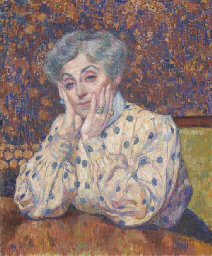

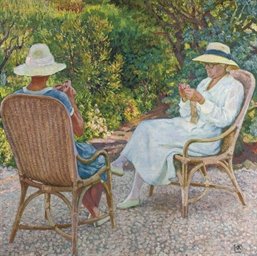
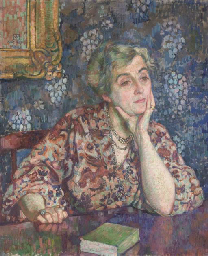
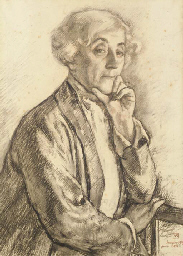
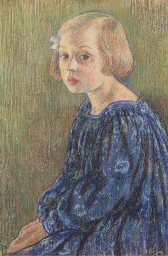
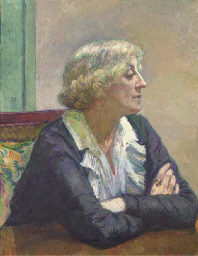
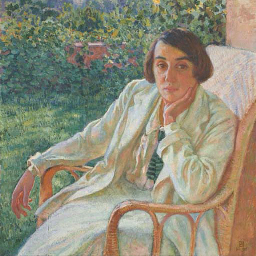
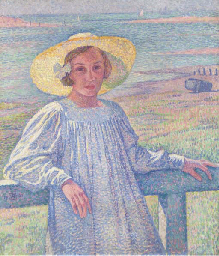
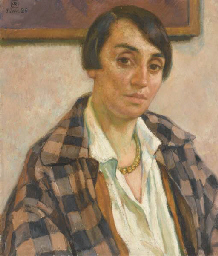
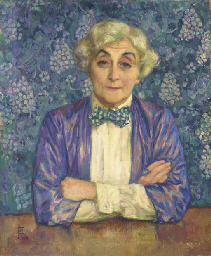
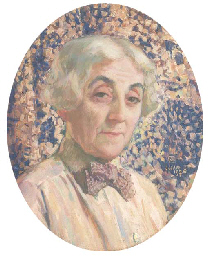
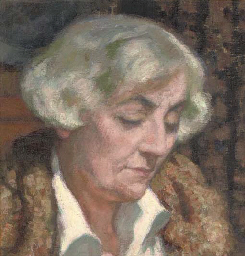
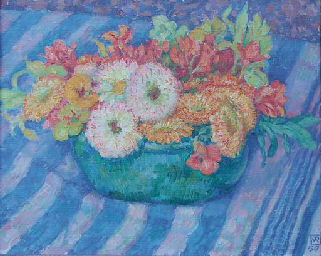
Testen Sie LotSearch und seine Premium-Features 7 Tage - ohne Kosten!
Lassen Sie sich automatisch über neue Objekte in kommenden Auktionen benachrichtigen.
Suchauftrag anlegen